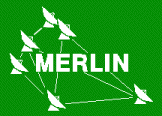
Newsletter

 |
Newsletter |
 |
| Number 4: March 2001 | ||||
| MERLIN | VLBI AT JBO | PROPOSALS | ARCHIVE | CONTACT |
| Contents | |
The deadline for proposals for Semester 01B on MERLIN is April 9, 2001. All details are in the MERLIN web area, specifically;
MERLIN will be offering all three standard frequency bands for 01B (L-band: 1330-1430 MHz, C-band: 4.5-5.2 GHz and 6-7 GHz, K-band: 21-24 GHz). C-Band and K-Band will be available from the start of the Semester. There will only be a single baseline between Cambridge and Mk2 available in the 6GHz to 7GHz methanol band. MERLIN+EVN observations at C-band will take place in November 2001 (applications should be sent to the EVN PC). The timing of the change of frequency to L-Band will be determined by the user demand, the availability of the Lovell telescope and the MERLIN TAG's view of the proposed science. There can only be one change between C/K-Band and L-Band. The system parameters for observation of a continuum source in good weather conditions are;
| L-Band | C-Band | K-Band | |
| Maximum angular resolution (mas) | ~150 | ~40 | ~8 |
| R.M.S. noise level for 12 hr. on source (microJy/beam) | ~60 | ~50 | ~400 |
| Maximum bandwidth per polarization (MHz) | ~15 | ~15 | ~15 |
The use of the Lovell telescope at L-Band reduces the 12 hour RMS noise level to ~35 microJy/beam. The maximum rate at which the observing frequency can be switched within an observing band will be approximately once every five minutes for multi-frequency synthesis observations. For spectral line work throughout the Semester, users are referred to Section 3.4 of the MERLIN User Guide Version 1.1. The maximum number of frequency channels per baseline to be divided between the 4 polarizations for bandwidths of 16 MHz, 8 MHz and 4 MHz are 64, 128 and 256, respectively. The number of frequency channels per baseline to be divided between the 4 polarizations will be 512 for bandwidths of 2 MHz or less. The minimum total bandwidth is 250 kHz.
Proposal forms, information on MERLIN Key Programmes, and further general information can be obtained via;
The period since the last Newsletter has been one of intense activity as we attempt to obtain funding for e-MERLIN. A major achievement has been the publication, and submission to PPARC, of the science case for the upgrade. A copy can be found on the web at:
A large number of astronomers from the UK and elsewhere made significant contributions to the science case and I thank them all for their efforts. It has been well worth it and has resulted in an impressive document.
At the end of November, PPARC announced that the British government is making funds available for the UK to join ESO. As you will be aware, this decision, although of great benefit to the long-term future of British astronomy, means that savings have to be made in the current ground-based programme. PPARC's Astronomy Committee met in early March and considered the ramifications in some detail. The results of their deliberations will be announced in due course.
At that same meeting, I made a presentation to Astronomy Committee of the science case for, and technical specification of, e-MERLIN. The case was well received and the committee expressed their strong support for the project. Unfortunately, due to the UK intending to join ESO, funds for new projects are extremely limited. However, the committee stated that if external funding for the construction of e-MERLIN could be found then they would be willing to see PPARC provide funds for the continued operation of the array. So, the search for the capital funds continues. Prof. Sir Martin Harris, Vice-Chancellor of the University of Manchester, and North West politicians have been making energetic efforts to help raise the £8.6M required. Watch this space for further developments.
While all this is going on, MERLIN operations continue apace. The array is observing at 5 and 22 GHz for this semester. One new development is the use of a single-baseline for CH3OH and excited-state OH observing, made possible by the construction of a new 6-7 GHz receiver for the 32-m at Cambridge (see below). Our current call for proposals states that all three principal frequencies will be available for Semester 01B. It is planned that MERLIN will therefore return after the summer engineering break at 5/22 GHz and will switch to 1.4/1.6 GHz around the end of November when the Lovell Telescope is once again operational.
The planned downtime of the Lovell Telescope is due to the second summer's work on its upgrade. Work will start around March 22 on the removal of the surface of the telescope, it is planned to replace approximately half the surface this summer and the second half next summer. This year will also see the replacement of the drive system, a lengthy and difficult operation that is setting the timetable for the return of the telescope to the astronomers. You can follow the progress of the telescope surface work through a special webcam, which can be accessed at:
The study of the dynamics of neutral gas in the centres of active galaxies is essential to our understanding of the physical processes that take place in these objects; processes such as the fuelling and triggering of AGN and starbursts. These studies have benefited greatly from the sub-arcsecond resolution achievable by MERLIN. A recent study of the HI absorption towards the centre of the peculiar radio galaxy 3C293, primarily using MERLIN, represents one of the highest angular resolution studies of the neutral ISM in a radio galaxy ever made. At L-band, MERLIN achieves an angular resolution of ~0.2 arsceconds which corresponds to a linear scale of just ~160 pc at the distance of 3C293 (assumed to be 180 Mpc). On these linear scales individual clumps of HI gas can be resolved against the radio continuum source.
3C293 is a peculiar radio galaxy assumed to be undergoing (or having recently undergone) some form of galaxy-galaxy interaction with a close partner ~28 arcseconds distant. The results of this interaction are clearly seen in optical images of the galaxy (see for example the extensive, filamentary dust lanes that cross the galaxies central region in the HST WFPC2 image, Figure 1a).
In addition to the optically distorted image, large quantities of neutral gas have been detected in the central few kiloparsecs of this source. This is probably the result of the cannibalisation of gas from the nearby companion.
Recent MERLIN results have been able to detect copious amounts of HI, via absorption, across the entire radio continuum source observed at this resolution. The high signal-to-noise levels achieved in these spectra have enabled the optical depth of HI, in front of the radio source, to be mapped, thus removing the scaling effects of the background sources flux density and revealing detailed structure of the HI gas. We find that there is a factor of 4 increase in the optical depth in 3 bands running approximately north-south across the source (see Figure 1b).
These bands appear to be co-spatial with the dust lanes seen in the HST optical image of similar resolution (Figure 1a). Figure 1c shows a position-velocity contour map of HI along the radio axis. The suspected position of the AGN core is labelled B. Two velocity gradients, interpreted as rotating rings of neutral gas, at position angle ~30 degrees, are clearly outlined centred upon the AGN core. Although the recent MERLIN observations were unable to fully trace the slower, outermost ring across its entire extent they have revealed the full extent of the inner higher-velocity gradient ring. We detect this ring to have a radius of ~600 pc and a velocity gradient of ~179 km/s/arcsecond. This implies a limit on the enclosed mass of 4.5x109 solar masses.
R. J. Beswick, A. Pedlar & A. J. Holloway, University of Manchester, Jodrell Bank Observatory.
Radio signals detected by any of the remote MERLIN telescopes are relayed to JBO via microwave radio links along with limited monitor and diagnostic information. However, in the event of a receiver fault it is necessary for engineers and/or technicians to visit the remote site (the furthest being 160 miles away by road) in order to determine the cause. It is common to require a second visit to repair the problem.
Recently, National Facility engineers have developed a comprehensive remote diagnostic system for the MERLIN receivers, based on National Instruments LabVIEW software. A prototype system has been installed at the most distant site at Cambridge. This allows engineers and technicians to perform a range of investigations and measurements on the telescope receivers from JBO, or any location with a telephone line, simply using a PC and a modem.
The system provides a number of measurement facilities, which were previously only available to engineers and technicians visiting the remote sites. These are spectrum analysis, system noise temperature measurement, system sensitivity measurement, antenna gain measurement and system power stability measurement.
There are substantial benefits of this scheme; causes of faults can be determined remotely, allowing repairs to be carried out more efficiently, and reducing the number of costly site visits. Routine testing of receivers is made very easy, allowing faults to be picked up early and facilitating the detection of degraded receiver performance.
It has previously been announced that an attempt was being made to equip the Mk2 and Cambridge telescopes with 5 cm receivers for the current observing semester (01A), so that at least single, longbaseline observations of the excited OH lines at ~6030 MHz and ~6035 MHz and the Methanol line at ~6668.5 MHz could be made. Once equipped, the Mk2 and Cambridge telescopes would also be able to contribute to 5cm VLBI observations. Observing time was allocated provisionally by PATT for the current semester in the hope that the receivers would be successfully built and installed. This has in fact happened and the first 6 GHz fringes were obtained on 7 March. The receiver on the Cambridge telescope is cooled, and though it has not been accurately measured, the system temperature of the Cambridge telescope at 6 GHz is approximately 50K to 60K. The Mk2 receiver is uncooled, so that the Mk2 has a correspondingly higher system temperature of ~80-90K. Many observations of PATT approved programmes at 6 GHz have already been made and an initial reaction is that their quality is very good. Figure 3 shows examples of spectra obtained from phasereferenced observations of W3 (OH) centred at the two OH line and Methanol line frequencies. It should be possible to accurately locate the masers at the three different frequencies relative to each other and to the other OH maser lines.

|
Figure 3: Examples of MERLIN OH and CH3OH spectral observations of W3(OH). CLICK ON IMAGE FOR FULL SIZE VERSION. |